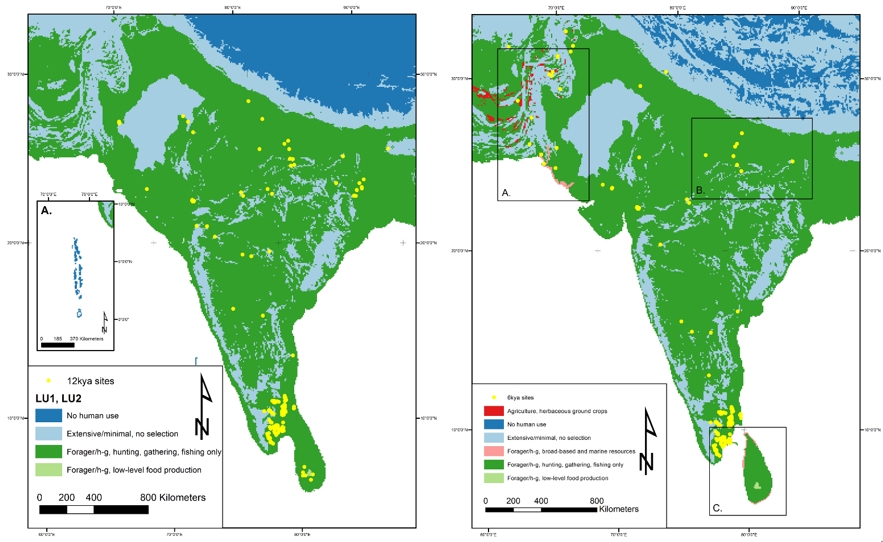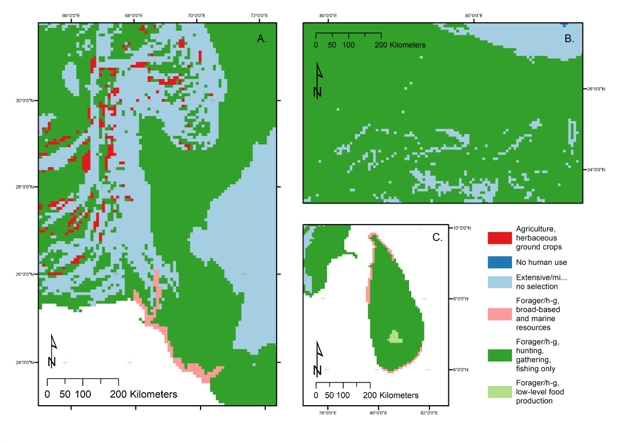[Necessity of the Research]
We are currently facing a global climate crisis of unparalleled scope and scale. The human role in this is clear – we are a key factor in the changes on our planet. In recent years climate scientists have been terming this new era the Anthropocene, to denote the human (‘anthropos’) driver of change. However, while we know human impact on the earth system is unprecedented in scope and scale less is known about the long-term histories of human land use and their effects on biodiversity, vegetation change, carbon cycling, soil carbon dynamics, and other factors relevant to climate change.
In this paper led by Seoul National University’s Prof. Jennifer Bates, from the Department of Archaeology and Art History, a team of specialists from across the world present the first large-scale synthesis of archaeological evidence for human land use in South Asia at critical phases for transitional lifeways in the Holocene (12,000 and 6,000 years ago), including the transition to agriculture, arguably one of the land use transitions most consequential in terms of human impact on the Earth system. The aims of the paper are to provide better data from archaeology to improve Anthropogenic Land Cover Change (ALCC) modelling – the method used to explore human impacts on the earth system in order to forecast our future role. ALCC models use past data to understand how climate changed over time and how this was linked to human actions, and then model what might happen in the future based on different human behaviors. These ALCC models have a huge impact on our lives today, as they predict climate change, theorize on the ways different actions could impact this, and are then used to advise policy.
[Outcomes/ Expected Impact]
South Asia has an extremely long history of human occupation, and is currently home to more than one billion people, making it a critical location for understanding the long-term histories and consequences of human land use. In this paper the team has shown that there were patterns of continuity and change in the actions of humans on land use over 12-6000 years ago. The most significant is that of hunter-gatherer-fisher-foragers, and the diversity of land use patterns people engaged in hunting, gathering, fishing and foraging could have, something left out of many narratives. There was a mosaic of strategies exploiting diverse and complex landscapes and ecologies, a pattern that has continued into the present. The continued role of such practices alongside agriculture is an important step for ALCC modelling of anthropogenic impacts on climate change as well as thinking about how to protect and preserve such unique lifeways in this day and age.
[Main Text]
We are currently facing a global climate crisis of unparalleled scope and scale. The human role in this is clear – we are a key factor in the changes on our planet. In recent years climate scientists have been terming this new era the Anthropocene, to denote the human (‘anthropos’) driver of change. However, while we know human impact on the earth system is unprecedented in scope and scale less is known about the long-term histories of human land use and their effects on biodiversity, vegetation change, carbon cycling, soil carbon dynamics, and other factors relevant to climate change.
In this paper led by Seoul National University’s Prof. Jennifer Bates, from the Department of Archaeology and Art History, a team of specialists from across the world present the first large-scale synthesis of archaeological evidence for human land use in South Asia at critical phases for transitional lifeways in the Holocene (12,000 and 6,000 years ago), including the transition to agriculture, arguably one of the land use transitions most consequential in terms of human impact on the Earth system. The aims of the paper are to show how data from archaeology can be used to improve Anthropogenic Land Cover Change (ALCC) modelling – the method used to explore human impacts on the earth system in order to forecast our future role. ALCC models use land cover and land use data from the past (hindcast data) to create a series of predictions and then look at what happens if a variable is changed in the future (forecasting). This provides an idea of what impact humans can have on the climate should we change our behaviours. However, land cover, the surface of the planet, has often been conflated with land use, the actions we have on this surface. This is problematic, as land cover, such as grassland, forests, can be used in many ways by humans, for example using grasslands in dry cereal agriculture or wet paddy rice agriculture, or as pasture spaces, or simply as recreational areas. All of these variations have different ramifications for the ALCC modelling predictions, and at the moment the nuances of what humans have done over deep time have not been adequately captured in the models. Better synthesis from land use specialists is needed.
The project, a Past Global Changes (PAGES) working group called LandCover6k, has been exploring this interaction between land cover and land use for the purpose of making better ALCC models to forecast (predict) future climate change due to human actions. The project involves climate modellers, land cover specialists (such as pollen analysts), and land use specialists (including archaeologists, anthropologists, historians) to truly link together these areas of research. The researchers come from many universities in Korea, India, Pakistan, Bangladesh, USA, Europe, China, and from across disciplines within the humanities, social science and hard sciences. LandCover6k's land use element of the project has multiple regional groupslooking to mapping deep time human actions at an 8x8km grid scale across the entire globe – far beyond any previously attempted. There are teams working on Europe, China, Korea, Africa all due to publish soon, with South Asia being a key region. This data is then passed to the ALCC modellers and used to improve the hindcast patterns and then improve the forecasting predictions of our actions.
South Asia has an extremely long history of human occupation, and is currently home to more than one billion people, making it a critical location for understanding the long-term histories and consequences of human land use. In this paper the team has shown that there were patterns of continuity and change in the actions of humans on land use over 12-6000 years ago. The most significant is that of hunter-gatherer-fisher-foragers, and the diversity of land use patterns people engaged in hunting, gathering, fishing and foraging could have, something left out of many narratives. There was a mosaic of strategies exploiting diverse and complex landscapes and ecologies, a pattern that has continued into the present. The continued role of such practices alongside agriculture is an important step for modelling anthropogenic impacts as well as thinking about how to protect and preserve such unique lifeways in this day and age.
As one of the most densely populated parts of the world today, South Asia is a critical location for studies of the effect of land use related land cover change on climate. Intensive agriculture, including large areas of wet rice, forest loss, mining and quarrying, modifications of the water table, and urban expansion have all profoundly affected earth systems. Understanding how these developed and what impact their historically contingent development has had over time and to the climate is vital to our future as a planet.
[Result]
Early to Mid-Holocene land use transitions in South Asia: A new archaeological synthesis of potential human impacts
J. Bates ,K. D. Morrison,M. Madella,A. C. Hill,N. J. Whitehouse,T. Abro,P. Ajithprasad,K. Anupama,A. Casile,A. Chandio,S. Chatterjee,K. Gangopadhyay,E. Hammer,S. Haricharan,M. Hazarika,R. Korisettar,A. Kumar,C. Lancelotti,S. Pappu,O. Parque,C. A. Petrie,R. Premathilake,V. Selvakumar,S. Sen,M. Spate,M. Trivedi,G. M. Veesar,V. Vinayak
(PLOS ONE, https://doi.org/10.1371/journal.pone.0313409)
- ○ALCC – Anthropogenic Land Cover Change modelhow climate modellers predict how humans will impact climate future, using past data from climate sources like ice cores, land cover data about the surface of the plant such as pollen cores, and human behaviour data like archaeology to hindcast (look back in time) to see if there are causative correlations, and the forecast (predict) how similar behaviours might lead to climate change in our near futures.
[Illustration Description]

Left: human land use at 12,000 years ago in South Asia, showing how most of the sub-continent was occupied by hunter-gatherer-fisher-forager groups.
Right: human land use at 6,000 years ago in South Asia, showing that while most of the sub-continent remains occupied by hunter-gatherer-fisher-forager groups the types of activities done had diversified, changing the land use in new and complex ways.

Inset for 6,000 years ago showing some of the fine details.

